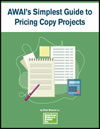The Formula for Properly Pricing Your Freelance Copywriting Fees

- Overcoming the dilemma of setting copywriting fees
- Two types of pricing and which to avoid
- Put a package of services together
- Just follow these 8 simple steps
- More ways to build your freelance business
No matter how long you’ve been a freelance copywriter, it’s normal to struggle with pricing your services — even veteran copywriters do, especially because things are constantly changing, including technology, social media, and more.
Plus, you may never have learned the proper way to price your services in the first place. So you may be practicing what I think of as “desperation pricing” — picking numbers out of the air that you imagine (i.e., hope) your clients can pay, then crossing your fingers.
The alternative is “profitable pricing,” which is based on figuring out what you need to make based on your carefully considered financial goals, balanced by what the market (i.e., your clients) will bear.
Once you’ve figured out what “profitable pricing” is for you, you are in a good position to standardize your pricing, which not only puts you in control, but speaks volumes about how you work — communicating loud and clear to your clients: “Here’s how I run my copywriting business: I know the type of projects I’m best at and how much I need to charge to be profitable doing them.”
When you package your copywriting services, you have an opportunity to standardize your pricing. You outline a simple suite of services that a client would need and sell it as a package, with a “package price.” It’s easier for everyone, and it helps you avoid the “desperation pricing” pit.
To package your copywriting services, here are eight simple steps to take:
Step 1: Choose which services to offer as a package. Ideally, it’s the services you want to do more of and the ones your clients need.
Step 2: Make a comprehensive list of all the elements included in that package. Then figure out what you must charge to do it profitably — how long does it take at your hourly rate? That’s your “premium” package, which you’ll offer at the highest price.
Step 3: To derive a “basic” or bare-bones version, take that list and subtract “bells and whistles” or the “nice-to-have” extras. How long would that reduced amount of work take to do? That’s your basic package, which you’ll offer at the lowest price. Be sure to add a couple of hours of cushion — just to be safe. Keep in mind that for some projects, valuable creative work goes into even the most basic offering because it takes time to do the basic research and get up and running. Make sure the price reflects that value.
Step 4: Now that you’ve got two ends of the spectrum, find the middle package. Give it a price — somewhere in between, but probably not exactly the middle.
Step 5: Put the packages away. Come back to them a few days later and see if they make sense. Did you leave anything out? Do the prices seem fair — to you and to your prospect?
Step 6: Try them out on your next prospect or run them by someone who knows your services or industry. Integrate any feedback you think makes sense.
Step 7: Don’t worry about whether any of your prices are “right.” You’ll find out once you start using the packages on real prospects.
Step 8: Revise as many times as necessary — the language, the pricing, the balance of features, how and when you present them — until it’s right. Consider this your 1.0 version. Start using them while simultaneously making notes about the next iteration.
Your takeaway: Complete these eight steps to package your copywriting services and you’ll enjoy stable pricing and clear communications with your clients.

AWAI’s Simplest Guide to Pricing Copy Projects
AWAI’s Simplest Guide to Pricing Copy Projects is the answer to your pricing questions. It is a simple guide for any copywriter who wants to quote, price, and negotiate fees like a professional. Learn More »
Guest, Add a Comment
Please Note: Your comments will be seen by all visitors.